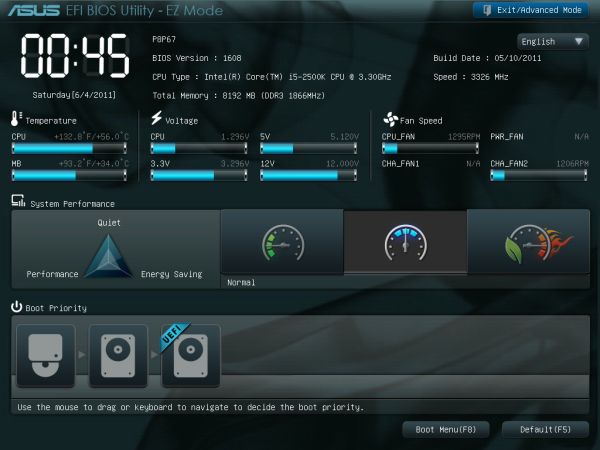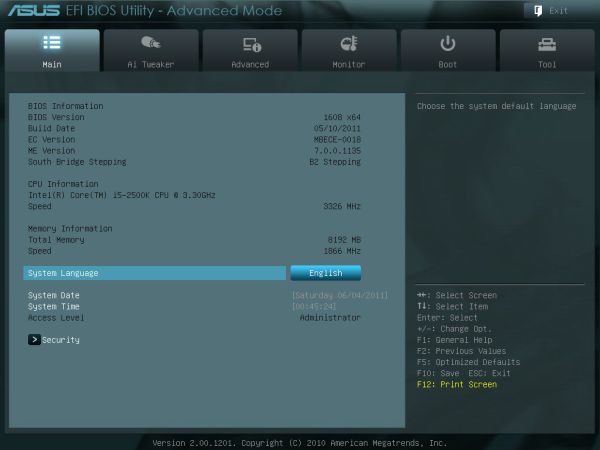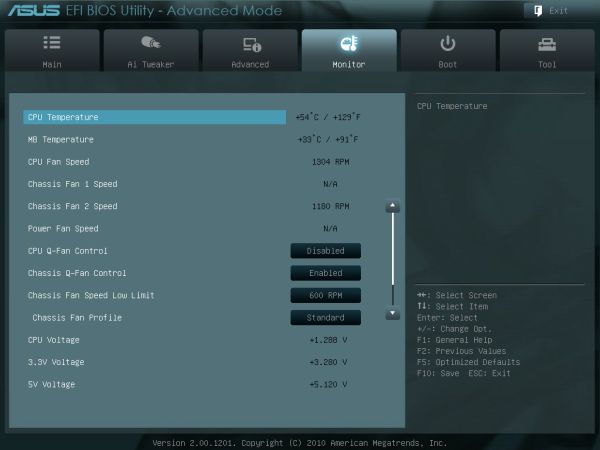ASUS P8P67 Review
by Brendan van Varik on September 8, 2011 10:45 AM EST- Posted in
- Asus
- Motherboards
- P67
BIOS
When you enter the BIOS for the very first time, you’ll be faced with the screen below. If you want to do any serious tweaking, you will have to enter the Advanced Mode, which you can do by clicking on the button located in the top right-hand corner.
At a quick glance, the basic BIOS layout shows more or less everything you need. It shows the CPU and motherboard temperatures, the voltages, fan settings with the current fan speeds and the boot sequence, which is switchable.
You can update the BIOS with relative ease with a USB flash drive. You will need to be in Windows in order to download the BIOS from ASUS’ website and to extract the .ROM file. It my experience, my 8GB stick was not detected, which is most likely a compatibility issue. However I did have a 4GB flash drive which did work in flashing to the latest BIOS.
The BIOS features a full UEFI system and it is easy to use. Everything is located where you would expect it to be and I can only find two issues with the BIOS. During this review, I used the 1608 BIOS which does not report CPU temperatures correctly. I also experienced that selecting the ‘OC Tuner’ option in the BIOS made the motherboard lock itself into an infinite boot cycle which would not disappear without a full CMOS reset.
After I did my testing, I updated the BIOS to the 1808 release which appears to have solved the CPU temperature issue.
As you can see from the screenshot above, there are not very options to change your fan settings. Just like in the ASUS Suite (noted in the software section of this review), you can choose from a few presets to change the fan speeds or you can manually assign some of your own.
Overclocking
As the ASUS Suite software allows gives us an option to ‘Auto Tune’ our PC from within Windows, I figured I would start out there. The 'Fast' pre-set was tested, giving a 31% overclock. It has increased the BCLK to 103 and the multiplier is set at 42. The RAM also got a boost up to 1866MHz by using X.M.P profiling.
After an hour at full load under OCCT, CPU-Z reported a maximum voltage of 1.296v when under load – my previous tests revealed that this particular CPU needed between 1.32 and 1.34v (set in the BIOS with high Load Line Calibration/‘LLC’) to be completely stable. The minimum voltage went down to 1.27v which could be tweaked a little with different LLC settings.
Considering how the software had taken care of the overclock, I was eager to try out the ‘Extreme’ preset. Sadly the results were not as impressive - the system attempted to raise the BCLK from 103MHz which it was set at from the ‘Fast’ pre-set to 103.5MHz. The system fell over and produced a blue screen. Once the system had restarted itself, it attempted to raise the BCLK to 103.5MHz again. It failed for a second time and on the third restart it left me with the same overclock as I originally had on the 'Fast' pre-set.
Using a maximum voltage of 1.42 V (1.75 V PLL) on the CPU, I was able to successfully boot up at 46x103 which gave me a final clock speed of 4738MHz. The system was nowhere near stable but it would get into Windows and run a few tests before crashing. By lowering the BCLK to 100 and increasing the multiplier to 47, I was able to get it stable enough to run all of our benchmarks. It was extremely easy to reach a 4700MHz clock speed. It was a case of finding the right voltage to match the given CPU frequency.
So, I removed the ‘safe’ voltage boundary and boosted the multiplier to see how far this board would really go. Just so that there was some extra headroom, the voltages got a slight increase, 1.5v on the core and the PLL voltage got a slight bump up to the original 1.8v. Windows would not boot at 5GHz, or 4.9GHz for that matter. At 48x100, Windows booted up straight away but when I tried to push the system past 101.5 BCLK, it would instantly result in a blue screen of death.
I decided to opt for a CPU voltage of 1.42 V and a PLL voltage of 1.75 V to do the rest of my testing with this motherboard. I wanted to demonstrate what sort of an effect overclocking has and what the benefits to it really are. In this instance, I ran our 3D Movement benchmark. I only ran the benchmark once to give you a rough idea of the performance gains. At stock speeds with turbo disabled, the overall score came in at 104.32 for the single threaded benchmark and 331.88 for the multi-threaded version. For a 29.7% overclock, there was a 27.8% increase (104.32 to 144.87) in performance using the single threaded application and a 30% (331.88 to 474.27) increase in the multi-threaded benchmark.



















52 Comments
View All Comments
pc_void - Thursday, September 8, 2011 - link
I'm in the middle of rma with a different Asus board atm that has to be counted by [gasp] months.zero2dash - Thursday, September 8, 2011 - link
[shrugs]I bought mine despite all those NewEgg reviews and [H] negativity (although that's primarily towards the Pro) and I've had 0 problems with mine.
Very happily running @ 4.6 with 16GB of ram (ie all dimm slots populated). No problems whatsoever.
Pick a board, there's always a problem here or there, it doesn't matter who the manufacturer is.
re: Asrock - I had an Asrock X58 Extreme die after Folding@home 24/7 for 2 months; after RMA'ing it I bought a Gigabyte and sold the Asrock. First and last time I'll buy an Asrock board.
pc_void - Thursday, September 8, 2011 - link
Btw, Asrock boards are also made where Asus boards are made @ Foxconn - that says quite a lot right there.faizoff - Thursday, September 8, 2011 - link
I have the Pro version of this board which I got for around $140 on a very short and quick sale on Amazon. Having owned this board for more than 5 months now I'm really enjoying it's overclocking performance. At first the board wasn't stable and I guess I tried to do too many things before letting it settle in. I remember many sites, when SB came out, most of the ASUS versions. At the time of my build I initially bought a Gigabyte UD3 board which turned out to be a decent overclocker. I regretted at that time for not getting an Asus board that had glowing reviews and ridiculous overclocking stories.After the board recall, I took that opportunity to turn the Gigabyte board in and switch to an Asus one. I think something may have gone amiss with the B3 stepping version of many P67 boards. I first got the Deluxe version and had to RMA that. From the getgo it would crash and hang, just when going through BIOS options.
Getting this board at first also wasnt smooth sailing. After managing to find a stable mini OC at around 4.0 Ghz, I have now OC'd it to 4.5 while maintaining the same temperatures on Hyper 212+ cooling (mid 30s C at idle and mid 50s C on load) and core voltage at max of 1.384 V.
I'm very happy with the board at the moment 5 months on and hope that it continues this way. I certainly hope to keep this computer for another 4-5 years at least. I went from a system with 2.0 Ghz E4400, 1.5 GB DDR, 128 MB Radeon 9600 XT AGP 8x, 15" monitor @ 1024 x 768 that still works 4 years later.
Upgraded to
Intel i5 2500k OC 4.5 Ghz
G. Skills Ripjaw series 8 GB 1333Mhz DDR3 RAM
Asus P8P67 Pro
Crucial 64GB C300 SSD
XFX 6870 1 GB Radeon HD
Asus 23" monitor @ 1920x1080
Rosewill 630w Single +12 V rail
Corsair 600T case (In the process)
gramboh - Friday, September 9, 2011 - link
Man, that is a serious upgrade, I took pleasure reading your post thinking how awesome it must have been to power that new machine up for so long, must have been mind blowing how much faster it was, especially upgrading from a low res monitor to that, lol.Ratman6161 - Thursday, September 8, 2011 - link
Its pretty well known that increasing bclk doesn't work well with socket 1155. With my Asrock Z68 Pro 3 and 2600K, ANY increase in bclk makes the system unstable. Lucky I have those multipliers to play with.With your max overclock you say: "I was able to successfully boot up at 46x103 which gave me a final clock speed of 4738MHz. The system was nowhere near stable but it would get into Windows and run a few tests before crashing."
I bet if you had backed it off to 46x100 = 4600 you might have gotten it stable and the extra 138 Mhz are rather meaningless anyway. Just a thought.
cactusdog - Thursday, September 8, 2011 - link
I have to agree with the guy about the reviews on here lately... too many smartphone reviews and random stuff most of us arent interested in.jecs - Friday, September 9, 2011 - link
I have this MOBO since day 0 as it was almost the only ASUS option in CompuUSA back in January 8.I am using a 2600K with this and I've been very happy with the performance and stability. Basically 0 fails. Also 98% of the time this machine is isolated from the internet with very specific software and system updates.
Ok, I read about 2 previous reviews about this ASUS MOBO, but my point here is how good it is for 3D applications for the price and all you care is gaming. Great!, no complains just an observation.
Also I am using 2 graphic cards I don't care about the limit in the second card as in my case I am using an entry level Quadro 600 for pro 3D viewport applications and for the 8X I am using a 460 GTX 1GB for a few games and game engines. It works very well for me and also for a new rendering application still in beta called Octane. This is my exclusive 3D machine, but I knew very well what I was going to do with this motherboard.
jecs - Friday, September 9, 2011 - link
As many of you I don't like the direction the computer industry is taking with tablets and smartphones, but I understand for the massive market a desktop PC or even a laptop is not the best option. Ouch, I hope not to see a considerable increase in prices for desktop parts in the next years.I like to think of this as a happy time of coincidence when power users benefited from the growing consumer market needs. But that ship is not with us anymore.
just4U - Friday, September 9, 2011 - link
I don't really see the point of this board anymore. At $140 it's not really one of the cheaper boards out there.. and for 20-30 dollars less you can opt out for the better performing Z68. (Sure it might be MATX but even so) It doesn't really have a place in the current lineup unless they lower the price down enough to make it make it interesting.